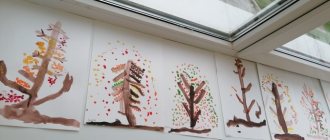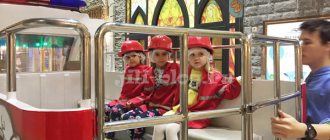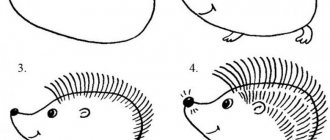project “Introduction to the profession of a cook”
If the vegetable has been named correctly, the teacher leaves it on the table, and the child must say where the item should be placed - on a plate or in a vase. (If the child makes a mistake, the vegetable is put back into the bag.) Children examine the vegetable, determine its color and shape. “This is the wonderful carrot Nikita found,” says the teacher and clarifies, “what is it like?” (“Long and plump, orange,” - choral answer and 1-2 individual ones.)
Appendix No. 5
Lesson summary:
“Excursion to the kindergarten kitchen”
Purpose:
introduce children to the work of a cook, expand and consolidate knowledge about kitchen utensils.
Preliminary work:
instructing children about the rules of conduct in the kitchen.
Excursion progress:
Guys, today we will go on an excursion to the kitchen of our kindergarten, which is located on the first floor. Who can answer: what is “kitchen”? (answers)
A kitchen is a room where food is prepared. I would like to remind you once again that this is a place of increased danger, because there are hot stoves and hot food in the kitchen. Therefore, I ask you to be very careful: do not push each other, so as not to get burned on the stove or pan.
Come on in, guys, they're already waiting for us. Say hello. We are met by the main cook - Nadezhda Petrovna and her assistant Elena Petrovna
Nadezhda Petrovna, please show us your work
space.
Cook: Guys, this room is called the kitchen. Here we prepare delicious food for you every day. What did you have for breakfast today? (answers) We, the cooks, prepared the porridge. To do this, we came to kindergarten very early, when both you and your parents were still sleeping in their warm beds. I turned on the electric stove and placed a huge pan on it. Then she poured milk into the pan, poured in cereal and sugar and, stirring with a large ladle, began to cook delicious, healthy porridge for you.
Nadezhda Petrovna, please show us the dishes in which the children’s breakfast is cooked.
Here in this large saucepan our chefs cook cocoa for the children.
Children, why do you think there are such big pots in the kindergarten kitchen? (children's answers) Do you have such pans at home? (answers)
Nadezhda, what does our guys have for lunch and dinner today? (answer) What kind of kitchen utensils will be used by chefs? (answer) What other kitchen utensils do you use to prepare food?
Cook: You need different kitchen utensils. We put the washed fruits in a special basin, and at home your mother uses a small bowl or plate for this. To add water, we use a ladle, and when your junior teacher Natalya Nikolaevna arrives, using a large ladle, the cook pours borscht into the bucket for the first course. In the kitchen we need not only kitchen utensils, but also various useful appliances and accessories. We have a special electric frying pan for frying cutlets. There is a potato peeler for peeling potatoes. To strain cooked pasta, you need a large colander. There are graters in the kitchen to grate cheese or carrots for soup. And, of course, you can’t do without knives and cutting boards in the kitchen. (The story is accompanied by a show)
Summary of the plot game “Cooking Lunch”. Lesson plan on the topic
Program content:
- Learn to name and consistently perform actions,
- clarify with the children the purpose of the dishes,
- develop initial role behavior skills,
- expand the vocabulary of “hot”, “sweet”, “serving”, “dishes” and activate their speech,
- to cultivate attentiveness, caring, a desire to take care of the doll, and a culture of behavior while eating.
Material : doll, kitchen and tableware - plates, forks, spoons, knives, cups, saucers, tablecloth, table, chairs.
Progress of the game:
Educator : Soon the doll Masha will return from a walk, she has been playing for a long time and is hungry, let's prepare her porridge and compote. But first we have to get dressed, because we are going to cook like real chefs. Aprons will prevent us from getting dirty, and scarves will prevent hair from getting into the food. (Children dress in aprons and scarves with the help of a teacher).
The teacher asks : -What dishes should I take?
Children : Pan, plate, knife, spoon, cup, board.
The teacher prepares the dishes (pot, knife, plate, cup) together with the children. Then he pours water from a bucket into a pan and puts it on the stove.
Educator : Children, what should you do with the fruit first?
Children : - Wash.
Educator : You need to wash the fruits correctly, otherwise harmful microbes will remain on them, and chop them finely. Dasha wash the fruits, and Aliya cut the fruits on the board.
Educator: What fruits did you cut?
Children : Apples, pear,
The teacher warns : - The water in the pan is already boiling, Nastya, put the fruit in the pan and stir with a spoon.
Educator : Now let’s add sugar, the compote will be tasty and sweet.
-Children, what kind of compote will it be?
Children: - delicious, sweet.
Educator : Let's taste the compote, cover the pan with a lid and let it continue to cook.
Oh, so many different things to do!
Now the compote is boiling,
And now for our doll,
We'll make some sweet porridge.
Educator : The compote is ready, put the pan aside and take out a box of cereal.
The teacher explains : - the cereal is called rice, rice porridge will be tasty, and the doll Masha will be happy.
Vosk : What kind of porridge will we cook?
Children : - Rice porridge.
The teacher pours the cereal into a plate, approaches the child and shows him the grains of rice.
Educator : - The water has already boiled, we need to wash the cereal. Alice, pour water into a small saucepan and wash the rice. Now pour the cereal into boiling water and cook the porridge.
The teacher, stirring the porridge with a spoon, says::
Yes, yes, yes - the porridge will be good.
Cook the porridge slowly.
Educator: While our porridge is being prepared, we need to set the table.
The children and the teacher set the table.
Educator : The porridge is ready, and Masha has come from a walk. Shall we feed Masha?
Children : Let's feed.
The teacher says : It’s unpleasant to eat with dirty hands, because worms can get into the tummy and Masha will get sick.
Children wash the hands of the doll Masha and sit him down at the table.
The teacher asks the children to wish the doll Masha a bon appetit. The children feed Masha, and the teacher says:
This-
Good girl
Her name is Masha!
And this is-
Her plate.
And in this plate...
No, not porridge,
No, not porridge,
And you guessed right!
Masha village,
Ate porridge-
All
How much they gave!
After lunch, the teacher invites one of the children to clear everything from the table
Role-playing game in the preschool educational institution “Smart Cooks”
Role-playing game in the preschool educational institution “Smart Cooks”
Playing with toy kitchens has a beneficial effect on a child’s early development and stimulates the development of logical thinking and fine motor skills. During the game, the child's imagination and imagination develops beautifully.
Kitchen is one of the favorite games for girls of preschool and primary school age. Its obligatory condition is the participation of several people, because what’s the point in cooking for yourself and treating yourself? Manipulating plates, cutlery and food develops the child's dexterity. The rules of serving and the ability to use a napkin are quickly and easily learned, and a rich stock of knowledge is accumulated about the methods of culinary processing of products and their compatibility. You can unobtrusively mention the benefits of vegetables and fruits, talk about the fact that different people have different gastronomic preferences.
Purpose of the game:
Through play, strengthen and deepen children’s interest in the profession of a cook, cultivate respect for work, the ability to work in a team, broaden their horizons, develop creative thinking and imagination.
Tasks:
1.
Teach children to expand the boundaries of the role-playing game “
Cook
” with new plot twists, plan the development of events, change the plot (if necessary) into a more interesting course of the game.
2.
Develop imagination and knowledge about the profession of a cook, encouraging initiative, resourcefulness and independence.
3.
Enriching children's vocabulary with words: (vegetables, fruits, meat, fish, cereals, etc.).
4.
Develop dialogical speech.
5.
Cultivate a desire to bring joy to people, the pleasure of preparing food and feeding it to others.
Equipment for the game:
Game module “Kitchen”: stove, sink. Utensils: pots, pans, microwave, kettle, mixer, plates, cups, spoons, forks, knives; cutting boards; napkins. Products: vegetables, fruits, bread, etc.
The teacher's task:
1.
Help the children organize the game, make it exciting and action-packed.
2.
Do not suppress their imagination, independence, spontaneity.
3.
Create interest in a particular life event, influence the imagination and feelings of children.
4.
To excite children with life events and labor feats, so that they want to imitate them.
Preliminary work:
1.
Excursion to the preschool kitchen.
2.
Stories from a teacher about the profession of a cook.
3.
Conversations: about the rules of etiquette, table setting, rules of conduct in public places
4.
Reading fiction, V. Mayakovsky “Who should I be?”, riddles about the profession of a cook.
5.
Examination of illustrations and pictures depicting the profession of a cook.
6.
Didactic games “Visiting”, “Setting the table”, “Polite words”; “Who should I be?”, “Guess the profession.”
7.
Memorizing a poem about chefs.
Progress of the lesson:
Educator:
Now I’ll tell you riddles about what we’re going to play now, and you guess.
1.
Walks around in a white cap with a ladle in his hand. He prepares lunch for us: Porridge, cabbage soup and vinaigrette. (Children-Cook)
2.
Tell me, who cooks cabbage soup so deliciously, Smelly cutlets, Salads, vinaigrettes, All breakfasts, lunches? (Children-Cook)
3.
He creates at the stove, as if he soars on wings. Everything is seething around him, the Kitchen is his forge. (Children-Cook)
4.
Who cooks cabbage soup, cutlets, borscht, dumplings, vinaigrettes; Cooks porridges and compotes, Fries entrecotes in oil, Mashes potatoes with a masher, Stirs soup with a ladle? He has a cheerful speech... And what is his name? ... (Children-Cook)
Educator:
Children tell a poem about cooks.
1.
Child.
Who is most needed in the dining room? Who cooks hundreds of dishes? Everyone will immediately answer in unison: His name is a cook.
2.
Child.
The cooks are very deft at peeling carrots with a knife, grinding cheese on a coarse grater: Back and forth, here and there.
3.
Child.
They stir the soup with a ladle and mash the potatoes with a masher. They cut the dill with a knife. Whack-whack-whack and into the bowl!
4.
Child.
It turns out delicious so that they personally take samples from the dishes so that our kids are always well-fed!
5.
Child.
He fries, steams and bakes - Here is the pie, here is the porridge... And for that, honor to him, Our gratitude!
6.
Child.
Maybe they won't believe me? Will someone smile? There is no more needed job on earth than a cook!
Educator:
Well done guys, do you know how to behave at the dinner table?
(Children's answers)
.
Away and at home for dinner.
You can't talk to your neighbor
No need to slurp and sniffle,
And also turn your head.
Distribution of roles:
Children independently distribute responsibilities, who will work as cooks and who will be guests. Then they change.
Guys, do you think cooking is easy? (Children's answers.)
Agree. In fact, cooking is a very responsible activity! To cook well, chefs study for a long time. And at first, things don’t always work out well for them; mistakes happen.
Educator:
Now we have assigned the roles, now choose the attributes you need and let’s start the game. Children set the table with dishes and cutlery. The cooks are preparing lunch. During the game, the teacher helps the children with unobtrusive advice.
Did you guys enjoy being chefs today? ( Children's answers.)
What did you like and remember most?
( Children's answers.
) Thank you, guys. You were all attentive, smart and resourceful. Watch your mothers cook.
At the end of the game we conduct an analysis.
1.
What products does the chef use to cook? (children's answers: from vegetables, fruits, meat, fish, cereals, etc.).
2.
Do you think the profession of a cook is interesting? (children's answers).
3.
Do people need this profession? (children's answers).
4.
What kind of person do you think a chef should be? (neat, kind, attentive). That's right, he always has clean clothes, clean hands, and the cook is attentive in preparing every dish.
5.
Did you like this game?






